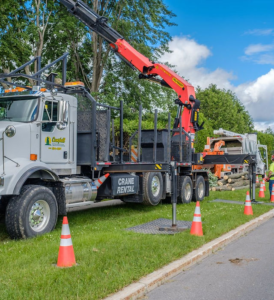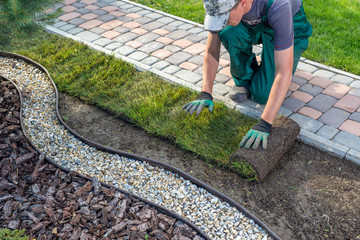Roofing Ormond Beach maintenance is essential for maintaining the structural integrity of a building. It prevents costly repairs and extends the lifespan of roofing materials.

Cleaning and clearing gutters, downspouts, and other roof drains of debris. This prevents water backup and clogged roof drain lines. It also helps reduce the occurrence of mildew and mold.
As winter fades into spring, it’s a good time to check out how your roof performed over the winter. If you noticed a few things like sagging, water spots or discoloration, this is an excellent time to schedule a professional roof inspection and repairs.
The mild weather of spring offers optimal roofing conditions for completing the necessary tasks and for ensuring that the roof can do its job of keeping moisture out. It also makes it easier for roofing professionals to access hard-to-reach areas of the roof. This is important because of the risk of falling and injury if workers have to perform roofing repairs in extreme temperatures or during snowy, windy conditions.
If you’re confident in your ability to inspect the condition of your roof, start by looking for any shingles that are missing or curling up. This is usually an indicator of a leak in your roof. If you notice that there are shingles missing, it’s a good idea to have a professional roofer come out for an inspection and repair.
It’s also a good idea to look for damage to your fascia and flashing. The fascia is the wooden or metal board that runs along the lower edges of the roof and covers exposed trusses and rafters. The flashing is a thin metal material used to seal joints in the roof, chimneys and roof valleys. Both of these components are essential to preventing water leaks in the attic and other parts of your home.
Leaks can be caused by damaged shingles, poorly sealed or improperly installed flashing and a variety of other factors. A regular inspection and preventative maintenance can identify these problems before they become serious and costly.
A leaky roof can cause severe water damage to the inside of your home. It can also lead to mold, rot and other structural problems. Having these issues fixed early by a roofing company can save you thousands of dollars and extend the lifespan of your roof.
Summer
When summer rolls around, most homeowners are thinking about vacations, outdoor activities, and the beauty of nature. It’s also a great time to focus on ensuring your roof is in good condition and protected against the harsh winter weather.
Roofing repair is often expensive, but it’s much more cost-effective to proactively identify and address issues in the summer. That’s why it’s important to clean debris, check gutters and drains, trim tree branches, re-seal caulking, remove moss or algae growth, and inspect and make any repairs needed.
Homeowners can do these tasks themselves or hire a professional to complete them. Roofing contractors are more available during summer, which makes it easier for homeowners to schedule repairs at a convenient time. Plus, working conditions are typically better in the summer than during colder months, allowing for more accurate assessments and repairs.
Gutters are a crucial part of the roof’s drainage system and help prevent water damage to a home’s foundation. However, over time they can become clogged with debris, and if left unattended this can lead to severe water damage to the roof, walls, insulation, and interior furnishings. Therefore, it’s essential to keep the gutters clear of leaves, twigs, and other debris throughout the summer, especially before heavy rainstorms arrive.
Another vital part of roofing maintenance is checking and re-sealing all fixtures that penetrate the roof, such as skylights, vents and pipes, and wire access points. These must be adequately sealed to keep moisture from seeping through the roof and damaging the rest of the structure.
Finally, a reputable roofing contractor will be able to advise homeowners on the most appropriate roof materials to ensure their properties stay watertight and energy efficient for as long as possible. High-quality materials like shingles and Ecolay synthetic underlayment protect against leaks and other damage, while offering significant benefits in terms of cost, durability, and environmental sustainability.
Fall
As the weather cools and leaves begin to turn color, many homeowners start thinking about preparing their homes for winter. While raking the yard and winterizing the garden often top the to-do list, it’s crucial that home and business owners don’t overlook roof maintenance as an important element of prepping for the cold months ahead.
Fall roofing maintenance provides a unique window of opportunity that can help prevent expensive repairs and costly issues in the future. From cleaning the gutters to inspecting the shingles, these preventative measures can go a long way in prolonging the life of a commercial or residential roof.
Gutter Cleaning
Fall is a great time to clean the gutters, as the mild temperatures and dry conditions allow roofing contractors to work more efficiently. During this cleaning process, it’s important to look for any areas of damage or wear that need to be repaired, such as clogs or holes in the gutter system, as these issues can lead to water leaks and other problems down the line.
Another crucial roof maintenance task is ensuring that the flashing around chimneys and vents are in good condition, as this prevents moisture from entering the home. If you notice any areas of damaged or deteriorating flashing, it’s a good idea to have them repaired by a professional roofer before the cold weather sets in.
It’s also a good idea to make sure that the eave and ridge vents in the attic are unobstructed, as this allows air to escape and prevents water buildup on the roof in the winter. It’s important to have any attic insulation that may be covering these vents professionally replaced as well, as this can also inhibit proper ventilation and increase energy bills in the winter.
Leaks and other roof damage are a common problem during the winter, and many of these issues are caused by existing weaknesses that are exacerbated by snow, ice and freezing temperatures. Conducting a thorough inspection of the roof in the fall can help identify these weak points and ensure they’re repaired before the harsh winter weather sets in, saving homeowners money and hassle in the long run.
Winter
The winter season poses unique challenges for roofs. Fortunately, a little preventive care can go a long way toward protecting your home’s topmost barrier against the harsh elements of winter. Known as winter roof maintenance, this proactive care is designed to address the specific conditions that can lead to expensive repair needs and long-term damage.
One of the most important things you can do to prepare your roof for the winter is to make sure your gutters are free of debris. Clogged gutters can cause water to back up onto the roof, leading to leaks and potentially structural damage. Additionally, they can also expose areas of the roof that are not in peak condition.
Another key step in preparing your roof for winter is to check the condition of your shingles. Look for loose or curling shingles, and address any issues as soon as you can to avoid further damage. Also, be sure to check the flashing around chimneys, vents, and skylights for any signs of rust or gaps. These are common causes of leaks in the winter, and addressing them now can help you avoid costly repairs down the road.
Other areas to focus on include the attic and insulation. Proper attic insulation helps maintain a consistent temperature and reduces heat loss, which can help you save on energy costs throughout the year. In addition, it can protect against ice dams and snow accumulation. Also, be sure to ensure proper ventilation in the attic to avoid moisture buildup and mold growth.
Finally, be sure to trim any trees that hang over your roof. Heavy winter snowfall and winds can wreak havoc on overhanging branches, so it’s important to keep them properly trimmed. This will not only improve safety, but it can also help avoid costly roof damage from fallen limbs in the winter.





